高中英语学业水平测试复习专题四语法填空语法项目(七)非谓语动词课件
文档属性
| 名称 | 高中英语学业水平测试复习专题四语法填空语法项目(七)非谓语动词课件 |  | |
| 格式 | ppt | ||
| 文件大小 | 1.5MB | ||
| 资源类型 | 试卷 | ||
| 版本资源 | 通用版 | ||
| 科目 | 英语 | ||
| 更新时间 | 2025-03-17 09:51:13 | ||
图片预览



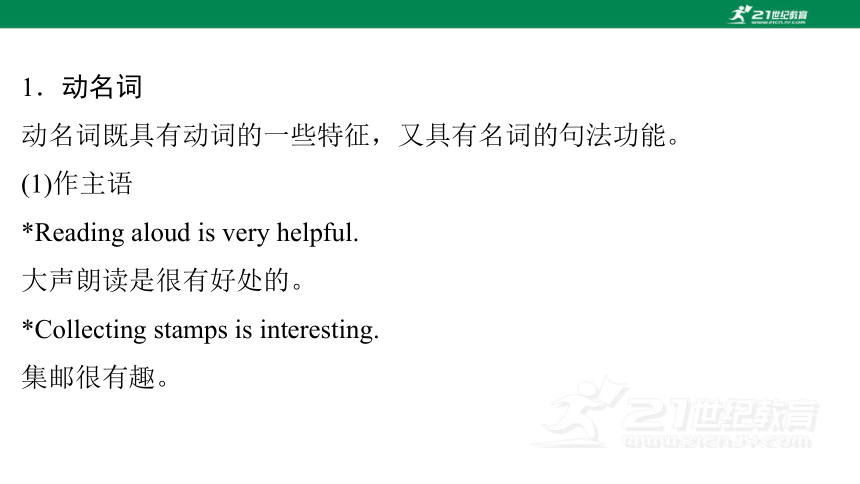
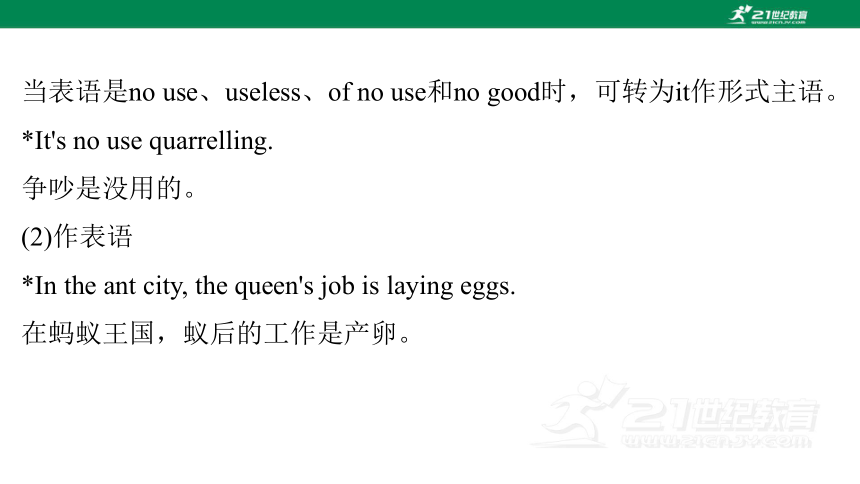

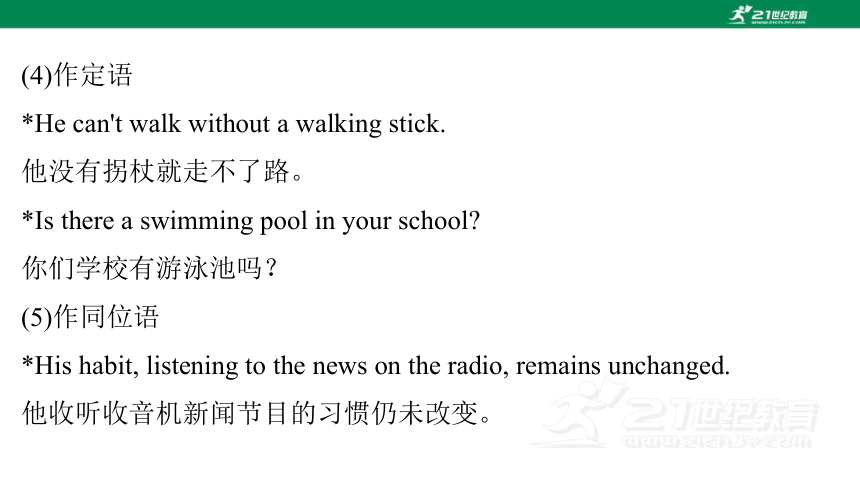
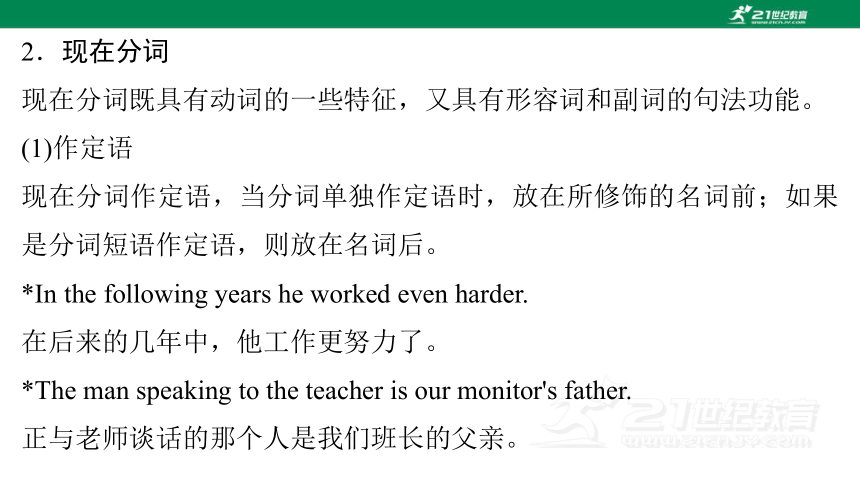
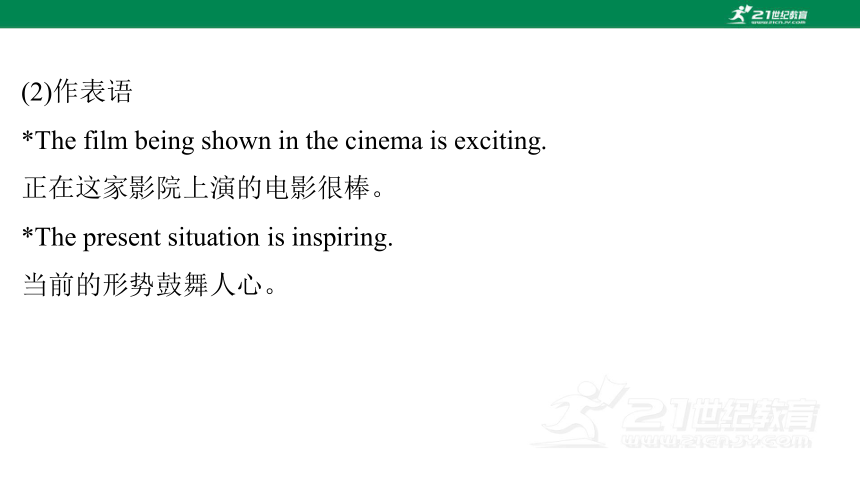

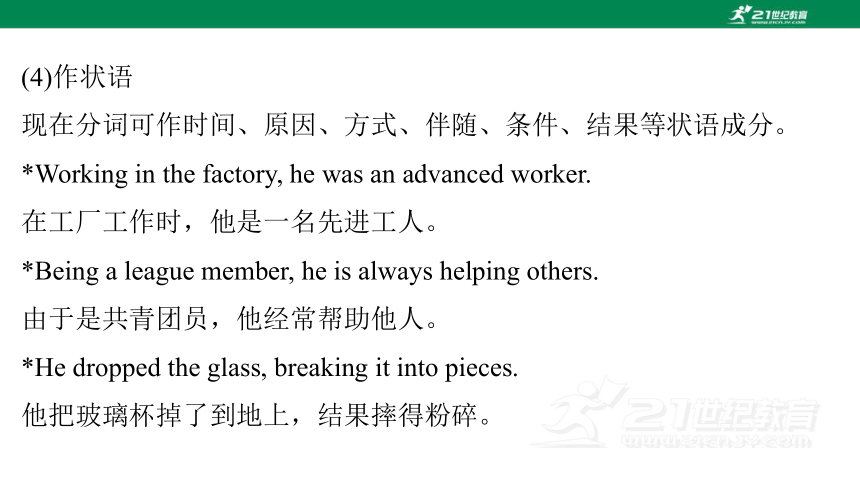

文档简介
(共39张PPT)
语法项目(七) 非谓语动词
知识梳理
PART
01
第一部分
不作句子谓语,而作句子的主语、表语、宾语、状语、定语或补足语等其他语法功能的动词,叫作非谓语动词。非谓语动词形式有:动词不定式(主动to do、to be doing和被动to be done);动名词(主动doing和被动being done);现在分词(主动doing和被动being done);过去分词(规则如failed和不规则如fallen)。非谓语动词的否定形式是将not放在非谓语动词之前,即not to do、not doing、not having done、not done四种基本形式。
1.动名词
动名词既具有动词的一些特征,又具有名词的句法功能。
(1)作主语
*Reading aloud is very helpful.
大声朗读是很有好处的。
*Collecting stamps is interesting.
集邮很有趣。
当表语是no use、useless、of no use和no good时,可转为it作形式主语。
*It's no use quarrelling.
争吵是没用的。
(2)作表语
*In the ant city, the queen's job is laying eggs.
在蚂蚁王国,蚁后的工作是产卵。
(3)作宾语
*They haven't finished building the dam.
他们还没有建好大坝。
*We have to prevent the air from being polluted.
我们必须阻止空气被污染。
(4)作定语
*He can't walk without a walking stick.
他没有拐杖就走不了路。
*Is there a swimming pool in your school
你们学校有游泳池吗?
(5)作同位语
*His habit, listening to the news on the radio, remains unchanged.
他收听收音机新闻节目的习惯仍未改变。
2.现在分词
现在分词既具有动词的一些特征,又具有形容词和副词的句法功能。
(1)作定语
现在分词作定语,当分词单独作定语时,放在所修饰的名词前;如果是分词短语作定语,则放在名词后。
*In the following years he worked even harder.
在后来的几年中,他工作更努力了。
*The man speaking to the teacher is our monitor's father.
正与老师谈话的那个人是我们班长的父亲。
(2)作表语
*The film being shown in the cinema is exciting.
正在这家影院上演的电影很棒。
*The present situation is inspiring.
当前的形势鼓舞人心。
(3)作宾语补足语
以下动词(短语)后可跟现在分词作宾语补足语:see、watch、hear、feel、find、get、keep、notice、observe、listen to、look at、leave、catch等。
*Can you hear her singing the song in the next room
你能听见她在隔壁房间唱歌吗?
*He kept the car waiting at the gate.
他让汽车在门口等着。
(4)作状语
现在分词可作时间、原因、方式、伴随、条件、结果等状语成分。
*Working in the factory, he was an advanced worker.
在工厂工作时,他是一名先进工人。
*Being a league member, he is always helping others.
由于是共青团员,他经常帮助他人。
*He dropped the glass, breaking it into pieces.
他把玻璃杯掉了到地上,结果摔得粉碎。
3.过去分词
过去分词只有一种形式:规则动词由动词原形加词尾-ed构成。不规则动词的过去分词没有统一的规则要求。过去分词的句法功能有:
(1)作定语
*Our class went on an organized trip last Monday.
上周一我们班开展了一次有组织的旅行。
(2)作表语
*They were frightened at the sad sight.
他们对眼前悲惨的景象感到害怕。
(3)作宾语补足语
*I heard the song sung several times last week.
上周我听见这首歌被唱了好几次。
(4)作状语
*Praised by the neighbours, he became the pride of his parents.
受到邻居们的表扬,他成为了父母的骄傲。(表示原因)
*Once seen, it can never be forgotten.
一旦它被看见,人们就忘不了。(表示时间)
*Given more time, I'll be able to do it better.
如果给予更多的时间,我能做得更好。(表示条件)
4.动词不定式
动词不定式具有名词、形容词、副词的功能。
(1)作主语
*To finish the work in ten minutes is very hard.
在十分钟内完成这项工作很难。
*To lose your heart means failure.
失去信心就意味着失败。
(2)作表语
*Her job is to clean the hall.
她的工作就是打扫大厅。
*He appears to have caught a cold.
他好像感冒了。
(3)作宾语
①后接动词不定式作宾语的动词有:want、hope、wish、offer、fail、plan、learn、pretend、refuse、manage、help、agree、promise、prefer等。如果不定式(宾语)后面有宾语补足语,则用it作形式宾语,真正的宾语(动词不定式)放在宾语补足语后面。
*Marx found it important to study the situation in Russia.
马克思觉得研究俄国形势很重要。
②动词不定式在固定用法中充当介词宾语。
*I have no choice but to stay here.
我别无选择只有待在这里。
(4)作宾语补足语
①动词不定式可充当一些动词(短语)的宾语补足语,如want、wish、ask、tell、order、beg、permit、help、advise、persuade、allow、prepare、invite、cause、force、call on、wait for等。以allow为例,其形式为allow sb./sth. to do。
*We don't allow the books to be taken out of the reading room.
我们不允许把书带出阅览室。
②动词不定式也可作少数介词如with的宾语补足语。
*With a lot of work to do, he didn't go to the cinema.
有很多事情要做,他没有去电影院。
③动词不定式作有些动词如make、let、see、watch、hear、feel、have等的宾语补足语时,可省略to,但改为被动语态时,不定式要加to。
*I saw him cross the road.
我看见他穿过马路。
*He was seen to cross the road.
他被看见穿过马路。
(5)作定语
动词不定式作定语,放在被修饰词之后。与所修饰名词有如下关系:
①动宾关系。
②说明所修饰名词的内容。
③被修饰名词是动词不定式的逻辑主语。
*I have a meeting to attend.
我有个会议要参加。(动宾关系是指 to attend a meeting)
*We have made a plan to finish the work.
我们制定了完成这项工作的计划。
*He is the first to get here.
他是第一个到这里的。
(6)作状语
动词不定式可以作目的、结果、原因等状语成分。
*He worked day and night to get the money.
为了赚钱他日夜工作。
*I visited him only to find him out.
我去拜访他,却发现他出去了。
*They were very sad to hear the news.
听到那个消息他们非常伤心。
技巧点拨
PART
02
第二部分
技法1 分析句子结构,判断是谓语动词还是非谓语动词
首先判定所给提示词是否充当句子的谓语,如果句子不缺少谓语,则用非谓语动词。
技法2 找逻辑主语,再判断与动词之间的关系
非谓语动词作定语时,其逻辑主语是被修饰词;作状语时,其逻辑主语通常是句子的主语;作补足语时,其逻辑主语是动词或介词的宾语。
分析非谓语动词与其逻辑主语(逻辑上的动作执行者)之间是主谓关系还是动宾关系(即判断其逻辑主语是动作的发出者还是承受者)。如果逻辑主语与非谓语动词之间是主谓关系,则用现在分词;如果非谓语动词与其逻辑主语之间是动宾关系,则用过去分词。但是当含有被动意义时,如果非谓语动词表示的动作尚未发生,则用动词不定式的被动式;如果非谓语动词表示的动作正在进行,则用现在分词形式的被动式。
技法3 判断所给动词与谓语动词发生的先后顺序
根据非谓语动词与谓语动词表示的动作发生的先后顺序确定用一般式还是完成式。如to have done、having done表示该动作发生在谓语动词表示的动作之前;to be doing、doing表示该动作与谓语动词表示的动作(几乎)同时发生。
专题训练
PART
03
第三部分
Ⅰ. 单句语法填空
1.The next morning he hired a boat and set out ____________(find) the well-known painter.
考查动词不定式。set out to do sth.意为“(怀着目标)开始做某事”。
2.You don't have to run fast or for long ____________(see) the benefit.
考查非谓语动词。此句意为“你不必跑得很快,也不必跑很长时间就见到效果”,不定式短语to see the benefit作目的状语。
to find
to see
3.You may drink, smoke, be overweight and still reduce your risk of ____________(die) early by running.
考查非谓语动词。介词of后接动名词形式。
4.They make great gifts and you see them many times ____________(decorate) with red envelopes and messages of good fortune.
考查非谓语动词。根据语境可知,them和decorate之间是逻辑上的动宾关系,故用动词 ed形式作宾语补足语,所以填decorated。
dying
decorated
5.This included digging up the road,____________(lay) the track and then building a strong roof over the top.
考查非谓语动词。设空处作include的宾语,应用动词- ing形式。laying和句中的digging up、building并列。
laying
6.The national park has a large collection of wildlife, ____________(range) from butterflies to elephants.
考查非谓语动词。句意:国家公园有大量的野生动物,从蝴蝶到大象不等。此处野生动物和range之间是主动关系,空格前有逗号,故用现在分词作状语。
ranging
7.The government encourages farmers to grow corn instead of rice ____________(improve) water quality.
考查非谓语动词。句意:为了提高水质量,政府鼓励农民种植玉米而不是水稻。空处应用动词不定式作目的状语。
8.Behind the simple style, however, is a serious message ____________(intend) for everyone.
考查非谓语动词。分析句子结构可知,空处为非谓语作后置定语。be intended for是固定用法,所以空处用过去分词intended。
to improve
intended
9.It is possible ____________(walk) or bike the entire 14 kilometers.
考查固定句型。分析句子可知,此处是固定句型“It is+adj.+(for sb.) to do sth.”,It是形式主语,动词不定式短语是真正的主语。
10.They are required____________(process) the food that we eat.
考查非谓语动词。句意:他们被要求加工我们吃的食物。 require表示“要求”, require sb.to do sth.表示“要求某人做某事”,被动形式为“sb. be required to do sth.”,表示“某人被要求做某事”。故填to process。
to walk
to process
Ⅱ.语法填空
在空白处填入1个适当的单词或括号内单词的正确形式。
There is a wonderful story about a young girl who had no family and no one 1.________(love) her.
One day,2.________(feel) very sad and lonely,she was walking through grassland when she noticed a small butterfly 3.________(catch) in a thorn bush.The young girl carefully released the butterfly.Instead of 4.________(fly) away,the little butterfly changed into a beautiful fairy.
to love
feeling
caught
flying
“In return for your wonderful kindness,”the good fairy said to the girl,“I will give you any wish that you would like 5.________(get).”The little girl thought for a moment and then replied,“I want to be happy.”
6.________(lean) toward her,the fairy whispered in her ear and then disappeared.
to get
Leaning
With the little girl 7.________(grow) up,there was no one in the land happier than she was.Everyone wanted to make themselves 8.________(tell) the secret of happiness by her.She would only smile and answer,“The secret of my happiness is that I listened to a good fairy when I was a little girl.”
growing
told
When she was dying,the neighbors all gathered around her,9.________(fear) that her unbelievable secret of happiness would die with her.So they begged her 10.________(tell) them what the good fairy said.The lovely old woman simply smiled and said,“She told me that everyone,no matter how old or young,how rich or poor,had need of me.”
fearing
to tell
语法项目(七) 非谓语动词
知识梳理
PART
01
第一部分
不作句子谓语,而作句子的主语、表语、宾语、状语、定语或补足语等其他语法功能的动词,叫作非谓语动词。非谓语动词形式有:动词不定式(主动to do、to be doing和被动to be done);动名词(主动doing和被动being done);现在分词(主动doing和被动being done);过去分词(规则如failed和不规则如fallen)。非谓语动词的否定形式是将not放在非谓语动词之前,即not to do、not doing、not having done、not done四种基本形式。
1.动名词
动名词既具有动词的一些特征,又具有名词的句法功能。
(1)作主语
*Reading aloud is very helpful.
大声朗读是很有好处的。
*Collecting stamps is interesting.
集邮很有趣。
当表语是no use、useless、of no use和no good时,可转为it作形式主语。
*It's no use quarrelling.
争吵是没用的。
(2)作表语
*In the ant city, the queen's job is laying eggs.
在蚂蚁王国,蚁后的工作是产卵。
(3)作宾语
*They haven't finished building the dam.
他们还没有建好大坝。
*We have to prevent the air from being polluted.
我们必须阻止空气被污染。
(4)作定语
*He can't walk without a walking stick.
他没有拐杖就走不了路。
*Is there a swimming pool in your school
你们学校有游泳池吗?
(5)作同位语
*His habit, listening to the news on the radio, remains unchanged.
他收听收音机新闻节目的习惯仍未改变。
2.现在分词
现在分词既具有动词的一些特征,又具有形容词和副词的句法功能。
(1)作定语
现在分词作定语,当分词单独作定语时,放在所修饰的名词前;如果是分词短语作定语,则放在名词后。
*In the following years he worked even harder.
在后来的几年中,他工作更努力了。
*The man speaking to the teacher is our monitor's father.
正与老师谈话的那个人是我们班长的父亲。
(2)作表语
*The film being shown in the cinema is exciting.
正在这家影院上演的电影很棒。
*The present situation is inspiring.
当前的形势鼓舞人心。
(3)作宾语补足语
以下动词(短语)后可跟现在分词作宾语补足语:see、watch、hear、feel、find、get、keep、notice、observe、listen to、look at、leave、catch等。
*Can you hear her singing the song in the next room
你能听见她在隔壁房间唱歌吗?
*He kept the car waiting at the gate.
他让汽车在门口等着。
(4)作状语
现在分词可作时间、原因、方式、伴随、条件、结果等状语成分。
*Working in the factory, he was an advanced worker.
在工厂工作时,他是一名先进工人。
*Being a league member, he is always helping others.
由于是共青团员,他经常帮助他人。
*He dropped the glass, breaking it into pieces.
他把玻璃杯掉了到地上,结果摔得粉碎。
3.过去分词
过去分词只有一种形式:规则动词由动词原形加词尾-ed构成。不规则动词的过去分词没有统一的规则要求。过去分词的句法功能有:
(1)作定语
*Our class went on an organized trip last Monday.
上周一我们班开展了一次有组织的旅行。
(2)作表语
*They were frightened at the sad sight.
他们对眼前悲惨的景象感到害怕。
(3)作宾语补足语
*I heard the song sung several times last week.
上周我听见这首歌被唱了好几次。
(4)作状语
*Praised by the neighbours, he became the pride of his parents.
受到邻居们的表扬,他成为了父母的骄傲。(表示原因)
*Once seen, it can never be forgotten.
一旦它被看见,人们就忘不了。(表示时间)
*Given more time, I'll be able to do it better.
如果给予更多的时间,我能做得更好。(表示条件)
4.动词不定式
动词不定式具有名词、形容词、副词的功能。
(1)作主语
*To finish the work in ten minutes is very hard.
在十分钟内完成这项工作很难。
*To lose your heart means failure.
失去信心就意味着失败。
(2)作表语
*Her job is to clean the hall.
她的工作就是打扫大厅。
*He appears to have caught a cold.
他好像感冒了。
(3)作宾语
①后接动词不定式作宾语的动词有:want、hope、wish、offer、fail、plan、learn、pretend、refuse、manage、help、agree、promise、prefer等。如果不定式(宾语)后面有宾语补足语,则用it作形式宾语,真正的宾语(动词不定式)放在宾语补足语后面。
*Marx found it important to study the situation in Russia.
马克思觉得研究俄国形势很重要。
②动词不定式在固定用法中充当介词宾语。
*I have no choice but to stay here.
我别无选择只有待在这里。
(4)作宾语补足语
①动词不定式可充当一些动词(短语)的宾语补足语,如want、wish、ask、tell、order、beg、permit、help、advise、persuade、allow、prepare、invite、cause、force、call on、wait for等。以allow为例,其形式为allow sb./sth. to do。
*We don't allow the books to be taken out of the reading room.
我们不允许把书带出阅览室。
②动词不定式也可作少数介词如with的宾语补足语。
*With a lot of work to do, he didn't go to the cinema.
有很多事情要做,他没有去电影院。
③动词不定式作有些动词如make、let、see、watch、hear、feel、have等的宾语补足语时,可省略to,但改为被动语态时,不定式要加to。
*I saw him cross the road.
我看见他穿过马路。
*He was seen to cross the road.
他被看见穿过马路。
(5)作定语
动词不定式作定语,放在被修饰词之后。与所修饰名词有如下关系:
①动宾关系。
②说明所修饰名词的内容。
③被修饰名词是动词不定式的逻辑主语。
*I have a meeting to attend.
我有个会议要参加。(动宾关系是指 to attend a meeting)
*We have made a plan to finish the work.
我们制定了完成这项工作的计划。
*He is the first to get here.
他是第一个到这里的。
(6)作状语
动词不定式可以作目的、结果、原因等状语成分。
*He worked day and night to get the money.
为了赚钱他日夜工作。
*I visited him only to find him out.
我去拜访他,却发现他出去了。
*They were very sad to hear the news.
听到那个消息他们非常伤心。
技巧点拨
PART
02
第二部分
技法1 分析句子结构,判断是谓语动词还是非谓语动词
首先判定所给提示词是否充当句子的谓语,如果句子不缺少谓语,则用非谓语动词。
技法2 找逻辑主语,再判断与动词之间的关系
非谓语动词作定语时,其逻辑主语是被修饰词;作状语时,其逻辑主语通常是句子的主语;作补足语时,其逻辑主语是动词或介词的宾语。
分析非谓语动词与其逻辑主语(逻辑上的动作执行者)之间是主谓关系还是动宾关系(即判断其逻辑主语是动作的发出者还是承受者)。如果逻辑主语与非谓语动词之间是主谓关系,则用现在分词;如果非谓语动词与其逻辑主语之间是动宾关系,则用过去分词。但是当含有被动意义时,如果非谓语动词表示的动作尚未发生,则用动词不定式的被动式;如果非谓语动词表示的动作正在进行,则用现在分词形式的被动式。
技法3 判断所给动词与谓语动词发生的先后顺序
根据非谓语动词与谓语动词表示的动作发生的先后顺序确定用一般式还是完成式。如to have done、having done表示该动作发生在谓语动词表示的动作之前;to be doing、doing表示该动作与谓语动词表示的动作(几乎)同时发生。
专题训练
PART
03
第三部分
Ⅰ. 单句语法填空
1.The next morning he hired a boat and set out ____________(find) the well-known painter.
考查动词不定式。set out to do sth.意为“(怀着目标)开始做某事”。
2.You don't have to run fast or for long ____________(see) the benefit.
考查非谓语动词。此句意为“你不必跑得很快,也不必跑很长时间就见到效果”,不定式短语to see the benefit作目的状语。
to find
to see
3.You may drink, smoke, be overweight and still reduce your risk of ____________(die) early by running.
考查非谓语动词。介词of后接动名词形式。
4.They make great gifts and you see them many times ____________(decorate) with red envelopes and messages of good fortune.
考查非谓语动词。根据语境可知,them和decorate之间是逻辑上的动宾关系,故用动词 ed形式作宾语补足语,所以填decorated。
dying
decorated
5.This included digging up the road,____________(lay) the track and then building a strong roof over the top.
考查非谓语动词。设空处作include的宾语,应用动词- ing形式。laying和句中的digging up、building并列。
laying
6.The national park has a large collection of wildlife, ____________(range) from butterflies to elephants.
考查非谓语动词。句意:国家公园有大量的野生动物,从蝴蝶到大象不等。此处野生动物和range之间是主动关系,空格前有逗号,故用现在分词作状语。
ranging
7.The government encourages farmers to grow corn instead of rice ____________(improve) water quality.
考查非谓语动词。句意:为了提高水质量,政府鼓励农民种植玉米而不是水稻。空处应用动词不定式作目的状语。
8.Behind the simple style, however, is a serious message ____________(intend) for everyone.
考查非谓语动词。分析句子结构可知,空处为非谓语作后置定语。be intended for是固定用法,所以空处用过去分词intended。
to improve
intended
9.It is possible ____________(walk) or bike the entire 14 kilometers.
考查固定句型。分析句子可知,此处是固定句型“It is+adj.+(for sb.) to do sth.”,It是形式主语,动词不定式短语是真正的主语。
10.They are required____________(process) the food that we eat.
考查非谓语动词。句意:他们被要求加工我们吃的食物。 require表示“要求”, require sb.to do sth.表示“要求某人做某事”,被动形式为“sb. be required to do sth.”,表示“某人被要求做某事”。故填to process。
to walk
to process
Ⅱ.语法填空
在空白处填入1个适当的单词或括号内单词的正确形式。
There is a wonderful story about a young girl who had no family and no one 1.________(love) her.
One day,2.________(feel) very sad and lonely,she was walking through grassland when she noticed a small butterfly 3.________(catch) in a thorn bush.The young girl carefully released the butterfly.Instead of 4.________(fly) away,the little butterfly changed into a beautiful fairy.
to love
feeling
caught
flying
“In return for your wonderful kindness,”the good fairy said to the girl,“I will give you any wish that you would like 5.________(get).”The little girl thought for a moment and then replied,“I want to be happy.”
6.________(lean) toward her,the fairy whispered in her ear and then disappeared.
to get
Leaning
With the little girl 7.________(grow) up,there was no one in the land happier than she was.Everyone wanted to make themselves 8.________(tell) the secret of happiness by her.She would only smile and answer,“The secret of my happiness is that I listened to a good fairy when I was a little girl.”
growing
told
When she was dying,the neighbors all gathered around her,9.________(fear) that her unbelievable secret of happiness would die with her.So they begged her 10.________(tell) them what the good fairy said.The lovely old woman simply smiled and said,“She told me that everyone,no matter how old or young,how rich or poor,had need of me.”
fearing
to tell
同课章节目录
